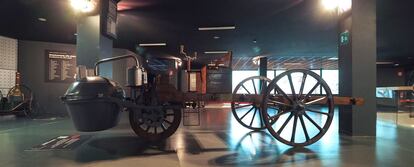It’s 250 years old and it still exists: The first automobile the world ever saw
The Cugnot ‘fardier à vapeur’ was designed in 1769 by a French military engineer looking for a new way to haul heavy equipment to the battlefield. It ultimately failed, but its legacy lives on

It was 1769. While missionaries sent by Charles III of Spain were founding the first cities in California and the explorer James Cook was discovering Tahiti, a French military engineer named Nicholas Joseph Cugnot was developing a mechanical system to carry heavy artillery pieces to the battlefield. It was the first automobile in history, a distant cousin of today’s cars.
Cugnot applied the principles of the steam engine, described one century earlier by his fellow Frenchman Denis Papin and perfected in 1763 by the Scotsman James Watt, in what would become a revolutionary invention that gave rise to the industrial era.
Cugnot’s contraption – officially called a fardier à vapeur or steam-powered dray in English – was made up of a gun carriage that would have normally been drawn by horses, but which was adapted for a large boiler where water was heated with firewood, which produced steam. When the steam reached a certain pressure, it powered the pistons of two side cylinders that moved notched discs. The system was similar to a clock’s gears and it transformed the linear motion of the steam engine into a rotational motion, activating the vehicle’s front wheel.
Its many detractors were surely delighted when the vehicle ran into a wall in what is believed to be the world’s first automobile accident.
Cugnot’s carriage was expected to reach a top speed of 9.3 mph (15 km/h), but the absence of any kind of pressure regulation in the boiler made it very difficult to control. To make things worse, the steering system was unwieldy and there were no brakes whatsoever. At nearly three tons of weight, it was not exactly an easy vehicle to handle.
According to testimonies from the era, one of the first tests, which reached speeds of around 3.1 mph (5 km/h), ended with the fardier crashing against a wall, and the project was dropped. But the idea lived on and some of the basic concepts of Cugnot’s vehicle were used later in the 19th century, and still live on to a certain degree in modern automobiles’ DNA.
The prototype built by Cugnot more than 250 years ago still exists and it is on display at the Museum of Arts and Crafts in Paris. In 2010, a group of engineering students built an exact replica and got it to work, driving it through the streets of Paris.
Tu suscripción se está usando en otro dispositivo
¿Quieres añadir otro usuario a tu suscripción?
Si continúas leyendo en este dispositivo, no se podrá leer en el otro.
FlechaTu suscripción se está usando en otro dispositivo y solo puedes acceder a EL PAÍS desde un dispositivo a la vez.
Si quieres compartir tu cuenta, cambia tu suscripción a la modalidad Premium, así podrás añadir otro usuario. Cada uno accederá con su propia cuenta de email, lo que os permitirá personalizar vuestra experiencia en EL PAÍS.
¿Tienes una suscripción de empresa? Accede aquí para contratar más cuentas.
En el caso de no saber quién está usando tu cuenta, te recomendamos cambiar tu contraseña aquí.
Si decides continuar compartiendo tu cuenta, este mensaje se mostrará en tu dispositivo y en el de la otra persona que está usando tu cuenta de forma indefinida, afectando a tu experiencia de lectura. Puedes consultar aquí los términos y condiciones de la suscripción digital.
More information
Últimas noticias
Venezuela hardens its ‘revolutionary state’ project amid pressure from Trump
Sydney Sweeney, the actress praised by Trump: ‘Women are up against what society wants them to be’
The Bolsonaro surname: An advantage or liability in Brazil’s 2026 presidential elections?
Raúl Rocha, from jet-setting with Miss Universe to arms trafficking and fuel theft
Most viewed
- Reinhard Genzel, Nobel laureate in physics: ‘One-minute videos will never give you the truth’
- Pablo Escobar’s hippos: A serious environmental problem, 40 years on
- Charles Dubouloz, mountaineering star, retires at 36 with a farewell tour inspired by Walter Bonatti
- Why we lost the habit of sleeping in two segments and how that changed our sense of time
- The fall of a prolific science journal exposes the billion-dollar profits of scientific publishing










































